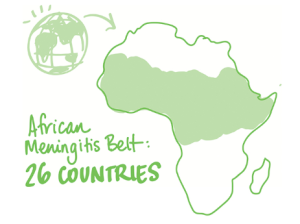There was a pervasive atmosphere of fear in the neighborhood; that feeling of ‘who knows whose turn it is to die’?
There has been a strange illness resulting in deaths that rather appear difficult to accept. A couple of people in the same household have been involved in some instances. What is frightening is the pattern. An apparently normal person will complain of a fever that looks like malaria, then the headache worsens, then the neck is stiff, then he gradually slides into unconsciousness and …then bad news. He’s dead.
The only consolation is that the disease has now been identified. It is a long jaw breaking word, Cerebrospinal Meningitis.
DEFINITION AND CAUSES
The Oxford English Language Dictionary defines meningitis as a serious disease in which there is inflammation of the meninges, caused by viral or bacterial infection, and marked by intense headache and fever, sensitivity to light, and muscular rigidity. Exactly what it is, a serious disease.
Meningitis can be viral, bacterial, fungal, or even cancerous in origin. In a short overview,

TRANSMISSION
Viral and bacterial meningitis can be contagious as they are transmitted by coughing, sneezing or close contact. Most of the bacteria that cause meningitis namely; Meningococcus, Pneumococcus and Haemophilus Influenzae and are carried in the human nose and throat.The bacteria that cause meningitis are transmitted from person-to-person through droplets of respiratory or throat secretions from carriers. Close and prolonged contact – such as kissing, sneezing or coughing on someone, or living in close quarters with an infected person, facilitates the spread of the disease. The average incubation period is 4 days but can range between 2 and 10 days.
Group B Streptococcus is found in the human gut and vagina and can spread from mother to child during childbirth.
The reality of spread by droplets is often a factor that is potentiated by dwellings that are crowded especially in certain seasons of the year, especially in Nigeria.
SIGNS AND SYMPTOMS
The symptoms of viral and bacterial meningitis can be similar in the beginning. Although it varies with age, bacterial meningitis symptoms are more severe.
Bacterial meningitis symptoms develop suddenly. They may include:
- altered mental status
- nausea
- vomiting
- sensitivity to light
- irritability
- headache
- fever
- chills
- stiff neck
- purple areas of skin that resemble bruises
- sleepiness
- lethargy
PREVENTION AND TREATMENT
There are vaccines to prevent getting Meningococcal meningitis.
The CDC recommends that anyone 10 years old or older who is at an increased risk for meningococcal disease get the MenB vaccine.
It’s also advised to visit the hospital if these symptoms are noticed, especially during an outbreak, for further examination and tests.
The 7th edition of the WHO Technical Taskforce (TTF) took place with the goal of leading and coordinating the implementation of the WHO Defeating Meningitis by 2030 Global Road Map, globally and regionally, by providing a forum for technical exchange and cooperation on meningitis and Road Map related activities.
Improving awareness and consciousness of responsible persons is necessary for reducing infection and negative impacts.
You may also like to read my earlier blogs on Cholera, Typhoid Fever, Climate Change, Malaria, Genital Herpes, Head Lice, Scabies, Telemedicine, Success Mindset, Conjuctivitis, Ebola Virus Disease, Hepatitis B, Measles, and Ear infecion.
We encourage active participation in community protection and personalized care.





